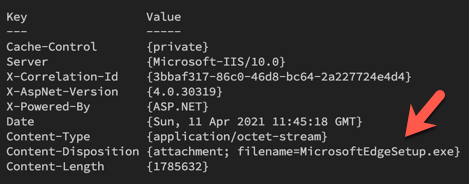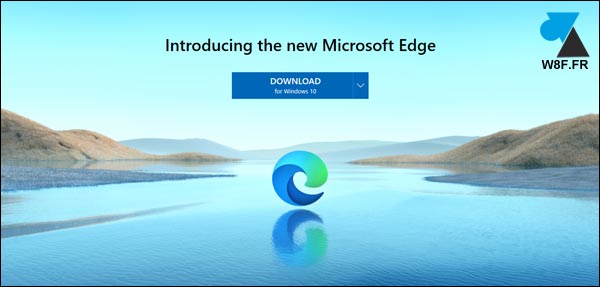[German]Microsoft offers the new Chromium-based Edge Browser since a few days now. However, the security of the provided Windows installer is quite poor.
- Microsoft Edge Setup.exe Download
- Microsoftedgesetup.exe Contained A Virus And Was Deleted
- Microsoftedgesetup
Microsoft Edge is the official browser from Microsoft that represents a total revolution with respect to the classic Internet Explorer. With a completely updated interface, it couldn’t be easier to access any of the features the browser offers. Although the first versions that arrived with Windows 10 were based on the same Explorer engine. How to install Microsoft Edge Chromium. Starting January 15, 2020, Microsoft is expected to begin the slow rollout of the new browser using Windows Update, which means that checking for updates. Download Microsoft Edge Preview Builds. Microsoft Edge Offline Installer. If you have multiple computers, then running an online installer would be a waste of time and bandwidth.
It was another ‘harmless’ mail I received from German security expert Stefan Kanthak. He asked me about the new Chromium based Edge browser from Microsoft:
have you already installed MicrosoftEdgeSetup.exe on Windows 7?
The installation program (a self-extractor) is once again industrial-
common insecure and broken junk… #
At this point I was curious and wanted to test it myself. So I quickly downloaded the installer and copied it into my test bed.
The test bed is provided by Stefan Kanthak, who deals with such security issues. You can download the file Forward.cab from his website and extract it into a folder. There is also a Sentinel.exe, which also need to be copies into this folder. The folder is then the test bed.
Note: If a virus scanner raise an alarm during visiting Kanthak’s website: He delivers the Eicar test virus in a data block attribute on its website to test whether browsers evaluate it and load it into memory for execution. A virus scanner should then be activated.
Installer Security Issues
With regard to the setup program (.exe file), Stefan Kanthak describes the following topics that caught my attention:
- 0. Only plus point: it does not request administrator rights at start-up;
- 1. but it loads at least VERSION.dll from its “application directory”;
However, when I listed the setup file MicrosoftEdgeSetup.exe, it wanted administrator privileges through User Account Control. There was also no alert when running it in my testbed.
After an exchange of a mail with Stefan Kanthak, the facts were clear. The Edge Setup file that loads the browser from the Internet does not need administrator rights. Rather, the program loads and unpacks the files needed for the Edge into a temporary directory before running. So it was clear why the testbed did not work. I then launched the downloaded setup exe file with the command:
MicrosoftEdgeSetup.exe /?
The installer and unpacker does not support options, but tries to call certain DLLs. And there I already got several warnings (see following picture) that DLL files would be reloaded from the current directory.
So the installer is vulnerable to DLL hijacking at least during unpacking. I have already warned here in the blog about several tools with such vulnerabilities. Unfortunately, Microsoft is also often present with their installers.
Unpack/dowload to a temp directory
Stefan Kanthak then noticed that the installer writes the files into the Temp folder of the user profile when it is executed:
it creates a subdirectory EUT<abcd>.tmp in the %TEMP% folder, in
that it unpacks its payload (see following list):
…EU753E.tmpMicrosoftEdgeUpdate.exe
…EU753E.tmpmsedgeupdate.dll
…EU753E.tmpMicrosoftEdgeUpdateBroker.exe
…EU753E.tmpMicrosoftEdgeUpdateOnDemand.exe
…EU753E.tmpMicrosoftEdgeUpdateComRegisterShell64.exe
…EU753E.tmpMicrosoftEdgeComRegisterShellARM64.exe
…EU753E.tmppsmachine.dll
…EU753E.tmppsmachine_64.dll
…EU753E.tmppsmachine_arm64.dll
…EU753E.tmppsuser.dll
…EU753E.tmppsuser_64.dll
…EU753E.tmppsuser_arm64.dll
…EU753E.tmpNOTICE.TXT
…EU753E.tmpMicrosoftEdgeUpdateCore.exe
…EU753E.tmpmsedgeupdateres_am.dll
…
…EU753E.tmpmsedgeupdateres_uz-Latn.dll
…EU753E.tmpMicrosoftEdgeUpdateSetup.exe
I could not find this directory on my drive. Later I found out that the installer deletes this directory after the installation. Only when I looked again during the setup process was the temporary folder there.
Malware has write and execute rights to temp
The Temp folder in the user profile can be filled with files by the user, including malware, at any time. Malware can therefore easily overwrite the Edge’s setup files in the Temp folder. These would then be executed during setup and the Malware would receive administrator rights from the installer. Stefan Kanthak writes about another problem:
3. unfortunately inherit the subdirectory and thus the unpacked files the inheritable NTFS access rights of %TEMP% … the since 20 years the entry
(D;OIIO;WP;;;;WD) alias “Prohibit file execution” included
So this crap of installer, created by bloody beginners, failed in an attempt to launch EU753E.tmpMicrosoftEdgeUpdate.exe without a further error message!
4. after I changed the NTFS access rights of …EU753E.tmp* before launcing …EU753E.tmpMicrosoftEdgeUpdate.exe the installer crap shows the window below with error code 0x80040C01.
This error code seems to be a universal code. This is because the error also appears when calling the setup program with the /? switch. Stefan Kanthak writes that the Help button displayed in the window calls the standard browser with this troubleshooting page. Unfortunately, the error code 0x80040C01 is not explained there.
The TenForums website does document error codes, but the above code is not included. The conclusion remains that the Edge Installer is not that exciting from a security point of view. Not so nice …
Advertising
This article describes the recommended practices for deploying Microsoft Edge in an enterprise environment.
Note
This article applies to Microsoft Edge version 77 or later.
The following sections provide specific guidance for planning your Microsoft Edge deployment.
Evaluate your existing browser environment and browser needs
Take time to understand your current browser state and project vision to ensure that all project stakeholders are aligned and working towards the same result.
Start by defining your current state:
- Which browsers are currently deployed in your environment?
- Which browser is set as the default browser?
- Do you need to use Internet Explorer for some of your apps?
- Do you use an Enterprise Mode Site List to configure Internet Explorer today?
- What OS platforms are supported in your environment? (Windows 10, macOS, Windows 7, Windows Server, etc.)
- What management tools do you use for browser management?
- Who is responsible for browser configuration and management?
- What is your process for validating browser compatibility?
After you understand the current state, you can determine the desired goals for your browser deployment, taking into account the following:
- Do you want to set Microsoft Edge as your default browser?
- How will you configure Microsoft Edge?
- What features are critical to configure as part of your initial deployment?
- What is the process for addressing any identified compatibility or configuration issues?

You should also understand the pre-requisites for features you're interested in, such as:
With these answers in mind, you're ready to planning your Microsoft Edge deployment.
Make sure your Windows 10 devices are ready
The Edge Stable channel requires the Latest Cumulative Update (LCU) from October 2019 (or later). If you attempt to deploy to a Windows 10 device that has an older LCU, then the installation will fail. For more details about the minimum LCU that must be applied before deploying Edge, see Windows updates to support the next version of Microsoft Edge.
Determine your deployment methodology
After you know your desired end state, you're ready to start planning how to get there. The two main ways to deploy Microsoft Edge are by role, and by site.
Deploy to end users by role
If app compatibility is your main concern, and you don't have a firm grasp on which apps to test, you might want to consider deploying to end users by role. This enables each wave of a phased deployment to provide feedback and insights on apps that might need to have their configuration modified to address compatibility issues.
Deploy to end users by site
If bandwidth is your primary concern, you might want to consider doing application compatibility testing up front. After you finish testing, deploy to end users by site so you can leverage caching other software delivery optimizations.
Do site discovery
If you have a dependency on legacy web applications, and plan to use Internet Explorer mode (which most customers do), then you probably need to do some additional site discovery.
If you've already deployed and configured the legacy version of Microsoft Edge
If you've already configured your Enterprise Site List to work for the legacy version of Microsoft Edge, then your work is almost done! The one thing you may need to add are neutral sites.
Neutral sites are typically sites that provide Single Sign-On (SSO). If you navigate to a neutral site from Microsoft Edge, then you want to stay in Microsoft Edge to authenticate. If navigate to a neutral site in Internet Explorer mode, then you want to stay in Internet Explorer mode to authenticate.
Identify any SSO (or other neutral) sites that you use and add these to your Enterprise Site List.
If you've configured Internet Explorer as your default browser
If you're currently only using Internet Explorer, you might not know which sites have upgraded to modern web standards and which still require Internet Explorer. You want to find these sites and add them to the Enterprise Site List. This lets you use Internet Explorer mode only on the sites that need it.
Tip
Use the Enterprise Site Discovery tools to discover the sites that might need Internet Explorer mode. You can collect collect data on computers running Windows Internet Explorer 8 through Internet Explorer 11 on Windows 10, Windows 8.1, or Windows 7.
Analyze site discovery data
After you've collected site data, we recommend the following 4-step process to analyze the data:
Sort the data by domain, and then by URL.
Define the boundaries of an 'app' to configure for Internet Explorer mode. You want to include all the sites and web controls that define the app. But you don't want to include any extra sites and controls by defining the app too broadly. Some sites may be as simple as 'http://contoso.com/app1' while others may require you to define multiple sites and pages.
Test the app to verify that it doesn't work natively. Many sites will offer modern content when they detect a modern browser, and only offer legacy content when they detect Internet Explorer.
Add the app to your Enterprise Site list if it fails testing.
Note
As a best practice, group all of the sites that comprise an app. If the sites all need to be used to accomplish one task, and if they tend to be updated together, that is a good indication that they should be grouped. This way, when you upgrade an app, it's easier to remove the entire site from Internet Explorer mode and start using a modern browser for that app.
Determine your channel strategy
Microsoft Edge is released in multiple channels.
Note

You can install more than one channel on a device
The Stable Channel is what you will want to deploy to most devices. However, you should consider a deployment strategy that includes multiple devices and multiple channels.
Multiple devices and channels
Microsoft Edge Setup.exe Download
We recommend having a representative subset of devices configured to use the Beta Channel. This lets you preview upcoming changes to the browser. You can see if these changes are going to affect your end users or apps.
You might also want to make the Dev Channel (or even the Canary Channel) available to some roles, such as web developers. Consider whether you would like to target some devices with more fluid and rapidly changing channels, or simply make these channels available for users to opt to install.
Because it's possible to install multiple channels on a device, you can mitigate the risk of testing for users who have opted to install a pre-release channel. For example, if you have a user who's using the Beta Channel, and there's a problem, they can switch to the Stable Channel and continue working. This unblocks them until the issue can be fixed.
Note
If the user enabled Sync, then their configuration will sync across channels, making it even easier to transition between channels.
Define and configure policies
After you've created your Enterprise Site List, we recommend identifying and configuring the policies that you intend to deploy with Microsoft Edge. This ensures that these policies are applied when you perform your testing.
First, consider the first-run experience you want your users to have. If you want to automatically import settings from the current browser, configure the policy for AutoImportAtFirstRun.
For security policies, we recommend starting with the Microsoft Edge Security Baseline. The Security Baseline can be applied using the recommended security configuration baseline settings or by using Microsoft Intune.
For other policies, we recommend reviewing the policy configurations for Microsoft Edge and Microsoft Edge Updates.
Define your update strategy and policies
You also want to determine how you want to do updates after you deploy Microsoft Edge:
Allow Microsoft Edge to update itself (default). If you choose to allow automatic updates of Microsoft Edge, then Microsoft Edge will automatically update itself at the pace determined by the channel(s) you deployed.
Update Microsoft Edge at your own pace. If you prefer to have explicit control over when updates are deployed, you can disable automatic updates and deploy it yourself (see the Update Policy reference.) After you disable automatic updates you can deploy updates for each channel using one of the following tools:
the deployment tool of your choice.
Regardless of your update strategy, we recommend leveraging a ringed deployment strategy. With automatic updates, this means having a representative sample of users running the Beta Channel, to identify issues with what will become the Stable Channel. With manual updates, this might also include additional validation of a pilot group after a new Stable Channel build is released. This is followed by broad deployment.
Note
Microsoft Edge support will only apply to the most recent version of Microsoft Edge in each channel
Do app compatibility testing

Application compatibility for Microsoft Edge is extremely high - so high that Microsoft provides the following compatibility promises:
Microsoftedgesetup.exe Contained A Virus And Was Deleted
- If it works on Microsoft Edge version 45 and earlier, it will work on Microsoft Edge version 77 and later.
- If it works on Internet Explorer, it will work on Microsoft Edge in Internet Explorer mode.
- If it works on Google Chrome, it will work on Microsoft Edge.
If you have an application where we don't meet our compatibility promise, then we stand behind the promise to fix it with Microsoft App Assure.
Internal line of business app testing
Despite our compatibility promise, we know that many organizations must validate some applications for their compliance or risk management reasons. Even though we expect this to be very straightforward, it's important to be organized and rigorous in app testing.
There are 2 ways to do app compatibility testing:
- Lab testing. Applications are validated in a tightly controlled environment with specific configurations.
- Pilot testing. Applications are validated by a limited number of users in their daily work environment using their own devices.
Choose the method that is most appropriate for each app, to manage risk without over-investing in compatibility testing.
Third party app support
In addition to their own line of business apps, many organizations use apps provided by external sources. The Ready for Microsoft Edge article contains a list of web applications that may be in use within your organization. This list provides links to provider support statements for their products when used with Microsoft Edge.
Deploy Microsoft Edge to a pilot group
After you've defined your policies and have finished your initial app compatibility testing, you're ready to deploy to your pilot group. Deploy to your pilot group using one of the following tools:
- Microsoft Intune for Windows, or Microsoft Intune for macOS
- Configuration Manager.
- Another management tool, download and deploy the MSI file for Microsoft Edge.
Validate your deployment

After you deploy your pilot, you want to capture all the feedback you get from your users.
- Capture feedback on compatibility. Identify sites that belong on the Enterprise Site List that weren't identified during site discovery.
- Capture feedback on the policy configuration. Ensure that users can use key features and do their work while following security guidelines.
- Capture feedback on ease of use and new features. Identify any areas where training should be developed and delivered based on user questions.
Broad deployment of Microsoft Edge
After a finishing the pilot and updating your deployment plan with lessons learned from the pilot, you're ready to do a full deployment of Microsoft Edge to all your users. Congratulations!
Microsoftedgesetup
See also
